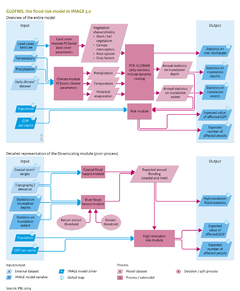Flood risks/Description: Difference between revisions
Jump to navigation
Jump to search
ArnoBouwman (talk | contribs) No edit summary |
ArnoBouwman (talk | contribs) No edit summary |
||
| Line 10: | Line 10: | ||
GLOFRIS estimates flood risk on two scales: that of 0.5 x 0.5 degrees for global analyses and that of 1 x 1 km<sup>2</sup> for specific case studies. On a global scale, the extreme value probability distribution is directly combined with data on population and GDP, using a linear flood level–damage relationship. This means that, for each year of simulation, the most extreme water level and inundated fraction from PCR-GLOBWB is used to calculate the maximum damage (in GDP or population) per grid cell. | GLOFRIS estimates flood risk on two scales: that of 0.5 x 0.5 degrees for global analyses and that of 1 x 1 km<sup>2</sup> for specific case studies. On a global scale, the extreme value probability distribution is directly combined with data on population and GDP, using a linear flood level–damage relationship. This means that, for each year of simulation, the most extreme water level and inundated fraction from PCR-GLOBWB is used to calculate the maximum damage (in GDP or population) per grid cell. | ||
An algorithm is implemented to scale down the 0.5 x 0.5 degree maps of the extent and depth of annual maximum inundation to 1 x 1 km<sup>2</sup>, using a high-resolution digital elevation model. A scale down is needed, because the spatial variability of both flood hazards and flood exposure may be large and are not well represented on the coarser scales of IMAGE and PCR-GLOBWB. Therefore, a more accurate estimation of flood risk is obtained by converting the results to a higher resolution. This downscaling procedure may also include the risk of coastal flooding (Model flow diagram of the downscaling routine on the right). | An algorithm is implemented to scale down the 0.5 x 0.5 degree maps of the extent and depth of annual maximum inundation to 1 x 1 km<sup>2</sup>, using a high-resolution digital elevation model. A scale down is needed, because the spatial variability of both flood hazards and flood exposure may be large and are not well represented on the coarser scales of IMAGE and PCR-GLOBWB. Therefore, a more accurate estimation of flood risk is obtained by converting the results to a higher resolution. This downscaling procedure may also include the risk of coastal flooding (Model flow diagram of the downscaling routine on the right). | ||
For the scaling down in river catchments, annual extreme values of inundation depths and fractions are transformed into bankfull volumes and excess volumes per 0.5 degree cell. The bankfull volume represents the volumetric capacity of a river channel within a particular grid cell and is estimated according to flood volume, associated with a user-defined return period in which flood volumes will not lead to exceeding the bankfull volume (return period threshold in | For the scaling down in river catchments, annual extreme values of inundation depths and fractions are transformed into bankfull volumes and excess volumes per 0.5 degree cell. The bankfull volume represents the volumetric capacity of a river channel within a particular grid cell and is estimated according to flood volume, associated with a user-defined return period in which flood volumes will not lead to exceeding the bankfull volume (return period threshold in the model flow diagram of the downscaling routine on the right) under current climate and land-cover conditions. The excess bankfull volume for each year is scaled down by estimating a water level from identified river pixels, determined by the user-defined stream threshold (see Model flow diagram of the downscaling routine on the right) that generates a flood volume in the surrounding connected pixels, resulting in the same flood volume, estimated from the 0.5 x 0.5 degree results. The method is therefore mass conservative with respect to the PCR-GLOBWB results on 0.5 degree cells. | ||
Coastal flood hazard maps are established using the [[DIVA model|DIVA database]]. DIVA contains estimates on 1-, 10-, 100- and 1000-year coastal water levels, along a large number of coasts around the world ([[Hinkel and Klein, 2009]]). These coastal flood probabilities are combined with those on river flooding by finding the upstream connected pixels within the high-resolution elevation map that have a lower elevation than the coastal water levels. In this computation it is assumed that, as a wave moves inland, its height will be reduced as the water spreads over the surface, resulting in lower water levels inland than at the coast. | Coastal flood hazard maps are established using the [[DIVA model|DIVA database]]. DIVA contains estimates on 1-, 10-, 100- and 1000-year coastal water levels, along a large number of coasts around the world ([[Hinkel and Klein, 2009]]). These coastal flood probabilities are combined with those on river flooding by finding the upstream connected pixels within the high-resolution elevation map that have a lower elevation than the coastal water levels. In this computation it is assumed that, as a wave moves inland, its height will be reduced as the water spreads over the surface, resulting in lower water levels inland than at the coast. | ||
Revision as of 12:54, 9 December 2013
Parts of Flood risks/Description
| Component is implemented in: |
|
| Related IMAGE components |
| Models/Databases |
| Key publications |
| References |
